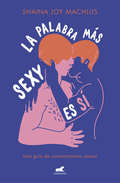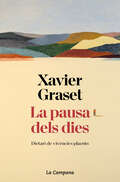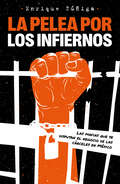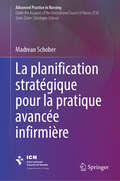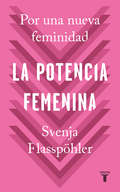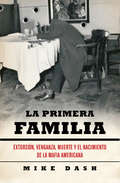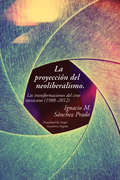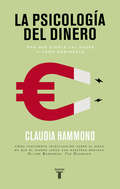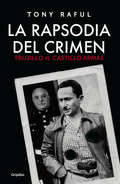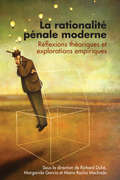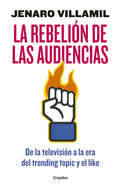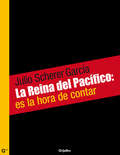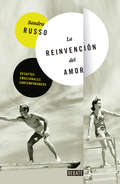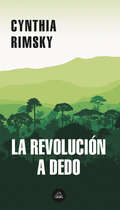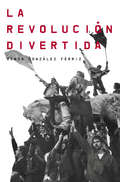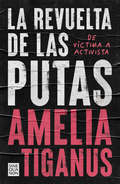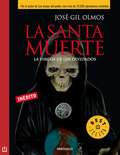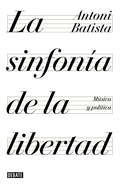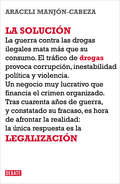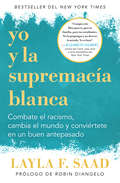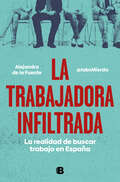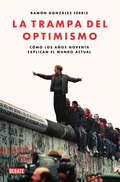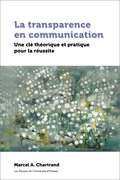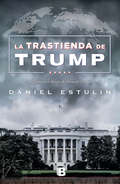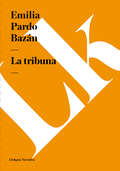- Table View
- List View
La palabra más sexy es sí: Guía para el consentimiento sexual
by Shaina Joy MachlusLa palabra más sexy es sí es una guía informativa, novedosa, y sexy sobre consentimiento y educación sexual y contra la cultura de la violación. El término «consentimiento» procede del latín consensus, «consenso», esto es, «acuerdo mutuo» de dos o más voluntades sobre una misma cuestión. Dice Shaina Joy Machlus en la introducción que «antes de que este libro fuera un libro, fue un fanzine, y antes de eso, fue un artículo. Pero, antes que nada, y lo más importante, es que fue un espacio vacío. El primer artículo que publiqué en español sobre consentimiento sexual fue un intento por llenar ese espacio. Lo que demostró ser como intentar arreglar una tubería rota con una bola de papel higiénico». La palabra más sexy es sí es una guía informativa, novedosa, y sexy sobre consentimiento y educación sexual y contra la cultura de la violación. Acompañada de las ilustraciones a todo color de la artista sueca Petra Eriksson -ilustradora habitual de The New Yorker-, nos brinda, de manera clara y concisa, la información necesaria para saberlo todo sobre orientación sexual, género, feminismo y consentimiento. La prosa de Machlus, tan fresca como certera, y las luminosas ilustraciones de Erikson entablan una conversación no solo apropiada sino absolutamente necesaria para personas de todas las edades.
La pausa dels dies: Dietari de vivències plaents
by Xavier GrasetXavier Graset ens ensenya a degustar i a viure la vida d'una manera pausada.Un dietari peculiar que ens farà reflexionar sobre el cicle dels «El recull del pas d'aquests dies que trobareu en aquest llibre entra en les petites històries del dia a dia: aquí trobareu terra, oliveres i avellaners, i aquí trobareu cuina, carxofes i bacallà, escarola, i fideus, trobareu festes, Carnaval i el cicle de Nadal, i la Mare de Déu d'Agost, trobareu teatre i més lectures, i trobareu calendari, trobareu allò que ens ha fet créixer, i de com ha anat canviant tot plegat, i compto que, en certa mesura, també us hi trobareu vosaltres».
La pelea por el infierno: Las mafias que se disputan el negocio de las cárceles en México
by Enrique ZuñigaCon su doble vena de criminólogo y reportero, Enrique Zúñiga analiza en este libro el peso específico que las prisiones tienen en el gran sistema criminal de México y desvela la guerra oculta -y el botín inmenso- que se disputa en cada uno de estos lugares. Cada cárcel en México es un infierno particular. Algunas prisiones tienen salas de tortura, otras poseen cuartos de ahogamiento, algunas más son emporios criminales bien aceitados y otras han sido sitios de exterminio; ciertos reclusorios han devenido cuarteles para reclutar masivamente carne de cañón, y otros, en cambio, son fortalezas perfectas para que los capos pacten el rumbo del crimen y de grandes regiones del país. En algunas penitenciarías se promueve la industria de la extorsión, en otras, la violación a escala industrial... Enrique Zúñiga es una de las poquísimas personas que han atestiguado todos estos fenómenos. Durante lustros y lustros pudo entrar a una inmensa cantidad de cárceles debido a su trabajo de visitador penitenciario. De Chihuahua a Acapulco, de Topo Chico a Tamaulipas, del Estado de México a Cadereyta, logró entrar a rincones a los que ninguna autoridad podría acercarse y conseguir testimonios inaccesibles a cualquier juez. Con su doble vena de criminólogo y reportero, Enrique Zúñiga analiza en este libro el peso específico que las prisiones tienen en el gran sistema criminal de México y desvela la guerra oculta -y el botín inmenso- que se disputa en cada uno de estos lugares.
La planification stratégique pour la pratique avancée infirmière (Advanced Practice in Nursing)
by Madrean SchoberCet ouvrage très attendu permet aux lecteurs de comprendre la dynamique des processus politiques, la recherche de pertinence dans les prises de décision et l’importance des décideurs clés. Il met également l’accent sur la nécessaire mobilisation des compétences en matière de négociation et de diplomatie pour soutenir l’introduction de la fonction d’infirmière pratique avancée (IPA) ; ce projet requiert l’identification et l’exploration des questions essentielles qui permettront de s’assurer que les infirmières puissent libérer leur potentiel. Les sujets abordés comprennent une définition de la planification stratégique, les facteurs essentiels à prendre en compte et les cadres de référence à utiliser dans le contexte de la formulation de politiques efficaces. En abordant les indicateurs de résultats et la contribution de la recherche, ce volume offre une approche complète de la planification coordonnée et intéressera les infirmières en pratique avancée, les planificateurs et les décideurs en matière de soins de santé, ainsi que les administrateurs d’hôpitaux et d’établissements de soins de santé.
La potencia femenina: Por una nueva feminidad
by Svenja FlabpöhlerUna vía alternativa para el feminismo del siglo XXI. En el marco de los debates provocados por la eclosión del movimiento #MeToo, este libro presenta una postura original y contracorriente que sin embargo no abandona los postulados feministas y formula a la perfección una postura diferente y necesaria. Svenja Flasspohler aboga por una feminidad activa y rechaza la idea de la mujer como víctima, la antagonización hombres-mujeres y lo que la autora llama «feminismo de hashtag». Para algunos, los hombres están siendo sometidos a una caza de brujas. Otros afirman que el hashtag al fin arroja luz sobre un problema profundamente arraigado en nuestra sociedad: la devaluación de lo femenino. Svenja Flasspöhler elogia la voluntad de emancipación del movimiento, pero advierte que, lejos de acabar con la misoginia estructural, no hace sino reforzar su núcleo. Solo cuando las mujeres se comprendan a sí mismas y a su propio deseo se liberarán del papel de la víctima. Solo cuando no se limiten a exigir autonomía sino que se atrevan a vivirla lograrán empoderarse. Y solo sobre esa base puede lograrse una relación entre géneros exitosa.
La primera familia: Extorsión, venganza, muerte y el nacimiento de la mafia americana
by Mike DashUna exhaustiva investigación nunca antes realizada sobre los orígenes de la mafia estadounidense, tantas veces retratada en el cine y la televisión. Esta es la historia de los criminales más violentos y eficaces de la historia de Estados Unidos, y de cómo consiguieron salir de las aguas sicilianas para establecerse con éxito en Norteamérica. Y al mismo tiempo, es la historia de una familia: la primera familia del crimen organizado en Nueva York, un extenso y unido clan de extorsionadores y asesinos que abandonaron su hogar en el legendario corazón de la mafia, Corleone, para convertirse en los padrinos fundadores del nuevo mundo. Mucho antes que los Soprano, que el Padrino o que las cinco familias que han dominado el crimen organizado en Estados Unidos durante medio siglo, mucho antes que todos ellos, llegaron Giuseppe Morello y sus sangrientos hermanos. Por primera vez, un libro se nutre de archivos estadounidenses e italianos casi desconocidos, de documentos desclasificados de los servicios secretos, de los archivos policiales y judiciales neoyorquinos, así como de entrevistas con los últimos supervivientes de la familia Morello-Terranova, para contarnos el nacimiento de Little Italy y sus clanes mafiosos. La crítica ha dicho...«Un libro excelente de un historiador británico cuya capacidad para la investigación carece de límites. Dash se ha sumergido en toneladas de material para emerger con una obra de historia divulgativa en lo que probablemente sea el trabajo definitivo sobre la cuestión en los años venideros.»The Washington Post «Arrebatador, convincente, absorbente.»The New York Times «Cercana, personal, y repleta de detalles..., Dash constituye una rareza: es un metódico investigador y un escritor capaz de esculpir esta historia con una pluma tan perfecta y afilada como un estilete. Su estilo narrativo es novelístico, una apariencia desmentida por las extensas y precisas notas explicativas, que lo equiparan con algunos de los más reputados escritores sobre la mafia.»Toronto Globe & Mail
La proyección del neoliberalismo: Las transformaciones del cine mexicano (1988–2012)
by Ignacio M. Sanchez PradoCavernosa, usualmente fría, siempre oscura, con un ligero olor a palomitas de maíz en el aire: la experiencia de ir al cine es universal. No es menos intensa en México, donde la experiencia ha evolucionado de formas complejas en años recientes. Películas como Y tu mamá también, El Mariachi, Amores perros y las obras de los paradigmáticos Guillermo del Toro y Salma Hayek, reflejan mucho más un renovado interés por el cine en México. En La proyección del neoliberalismo, Ignacio Sánchez Prado explora precisamente los eventos que tuvieron lugar en la industria del cine mexicano durante las últimas décadas. Lejos de ser una simple historia del periodo, La proyección del neoliberalismo examina cuatro aspectos esenciales de las transformaciones ocurridas en la industria del cine mexicano: la caída del nacionalismo, un nuevo enfoque en audiencias de clase media, la redefinición del concepto de cine político y el impacto de la globalización. Este análisis incluye a directores y películas que han alcanzado notoriedad internacional o relevancia en la construcción de un mercado nacional. La proyección del neoliberalismo expone las consecuencias de una industria del cine forzada a encontrar nuevas audiencias entre la clase media mexicana para poder alcanzar el ansiado éxito económico y la aprobación cultural.
La psicología del dinero: Por qué ejerce tal poder y cómo dominarlo
by Claudia HammondLa psicología del dinero, de Claudia Hammond, es un examen científico de nuestra relación con el dinero, un estudio detallado del poder que éste ejerce sobre nosotros. Sabemos que lo necesitamos, y tendemos a querer más, sin tener en cuenta el modo en que afecta a nuestra mente, a nuestras emociones y a nuestro comportamiento. La actitud de cada uno de nosotros respecto a la deuda y el gasto es tan única e inevitable como una huella digital. Existen muchos libros sobre qué debemos hacer con el dinero, pero lo que analiza Claudia Hammond en este sorprendente y polémico libro repleto de anécdotas y ejemplos, es lo que el dinero nos hace a nosotros, al tiempo que nos muestra las extraordinarias herramientas que la psicología proporciona a la hora de tomar mejores decisiones monetarias. Reseñas:«Una fascinante investigación sobre el modo en que el dinero juega con nuestras mentes, y una útil guía para evitar que nos estafen -ya sean los demás o nuestra propia mente irracional.»Oliver Bukerman, The Guardian «En parte fascinante exploración psicológica, en parte guía práctica, el libro muestra las múltiples formas en que el dinero juega con nuestras mentes y los medios para manejarlo.»Telegraph «Fascinante y perspicaz... Hammond domina toda una batería de experimentos psicológicos que nos muestran cómo gastar (y ahorrar) más sabiamente.»Sunday Times
La rapsodia del crimen. Trujillo vs. Castillo Armas
by Tony RafulEl presidente de Guatemala Carlos Castillo Armas fue asesinado el 26 de julio de 1957, por una conjura dirigida por el dictador dominicano Rafael Trujillo Molina, el Generalísimo. Escrito a intervalos angustiantes, reproduciendo el espacio sonoro de los personajes, esta obra reúne toda aquella información que al autor le ha parecido indispensable para explicar la historia de este magnicidio. Dominicano por nacimiento y centroamericano por vocación, Tony Raful transita cómodamente en la historia, hurga en algunos nombres, los revive 60 años después, en un aquelarre centroamericano y caribeño de intrigas y acechanzas, más propio de la ficción, de un obstinado inventario de fábulas y ojerizas. El dictador Trujillo es omnisciente y temido. Su sombra ronda insepulta en esta obra. Es la historia de un ego mayor aupando un crimen, sin ninguna motivación ideológica ni política. Una muerte a destajo para resarcir un orgullo y castigar una ingratitud. Nada es invento. Sobre el apasionante discurrir de la trama del magnicidio aparecen los indicios, las culpas probatorias, las complicidades, los enlaces, los encubrimientos y sobreseimientos jurídicos. El autor sale al encuentro con las pruebas en sus manos, identifica los corolarios delirantes y patéticos, pero no tiene donde llevarlas, está fuera del tiempo. Entonces las vuelca como ofrenda y provocación, para que el relato de aquel crimen vuelva sorpresivo, con la impronta de sus motivos y el brazo largo del Generalísimo Trujillo, a saldar una deuda pendiente con la historia de Guatemala.
La rationalité pénale moderne: Réflexions théoriques et explorations empiriques (Perspectives alternatives en criminologie)
by Maíra Rocha Machado Margarida Garcia Richard DubéDouze ans après la création de la Chaire de recherche du Canada en traditions juridiques et rationalité pénale, ce livre rédigé par des chercheurs associés à cette chaire se veut un hommage à son titulaire, le professeur Alvaro Pires. L’ouvrage fait état des plus récentes recherches empiriques et réflexions théoriques liées au concept de « rationalité pénale moderne » (RPM). La RPM fournit une grille d’analyse pour l’observation et la description du droit criminel moderne et permet de soulever des questions pertinentes sur la criminologie et la sociologie du droit criminel. Les points abordés touchent notamment au renouvellement du débat sur la torture, à l’influence de l’opinion publique sur le rendement de la justice, à la reconnaissance des droits de l’homme dans le droit criminel et à la représentation des juges et des politiciens dans les processus de détermination des peines et d’élaboration du droit pénal. Au-delà des spécificités de chacune des contributions, un thème général ressort de l’ensemble de l’ouvrage : celui de la transformation du droit criminel moderne. Ainsi, à l’aube du XXIe siècle et dans le cadre des sociétés dites « modernes », l’évolution d’un système social – qui (sur)valorise l’idéal de justice à travers des valeurs négatives telles que l’enfermement, la distribution de la souffrance et la production de l’exclusion sociale – demeure au centre de la réflexion. L’ouvrage cerne les obstacles cognitifs qui nuisent à l’évolution du droit criminel et à l’émergence d’idées innovantes susceptibles de soutenir et de motiver des pratiques alternatives. - Ce livre est publié en français.
La rebelión de las audiencias: De la televisión a la era del trending topic y el like
by Jenaro VillamilLa rebelión de las audiencias es una obra indispensable para entender cómo la convergencia tecnológica puso en jaque a la estructura abusiva del poder mediático en México. En menos de una década pasamos del imperio del rating al dominio del mundo hiperconectado por medio de empresas como Google, Facebook, Twitter, Apple o Netflix. La televisión ya no nos gobierna. Como explica Jenaro Villamil en este notable análisis de los medios de comunicación, el Big Brother orwelliano de la pantalla televisiva se desplazó al de la pantalla telefónica y los dispositivos móviles, pero con un sutil y riesgoso cambio de ecuación para las élites: los vigilados pueden vigilar, las audiencias pueden producir contenidos, los ciudadanos pueden reclamar sin mediación. La conectividad y la interacción han convertido la galaxia comunicacional en un nuevo y complejo sistema con posibilidades aún inciertas. La rebelión de las audiencias aporta elementos de discusión teórica y descripción periodística de los fenómenos televisivos y digitales, hace una revisión histórica desde el punto de partida hasta las últimas reformas legales en materia de telecomunicaciones, y ofrece además un acercamiento a las claves del mundo de las redes sociales y el homo zapping. En palabras del autor: "El 80% de las audiencias que se informan a través de medios digitales son audiencias que están en franca rebelión contra la línea informativa y de entretenimiento de Televisa, y ésta ya no tiene credibilidad."
La reina del pacífico: es la hora de contar
by Julio Scherer GarcíaUn extraordinario reportaje que muestra a la mujer-mito del narco mexicano tal cual es: explicando lo que significa nacer, crecer y vivir en ese mundo, contando sus experiencias con los grandes capos y los narcopolicías, revelando las entrañas de ese infierno y también su intimidad... todo ello gracias al enorme oficio del mejor periodista de México. Resultado de una larga serie de entrevistas a Sandra Ávila, la Reina del Pacífico, contiene el primer testimonio sobre lo que significa nacer, crecer y vivir dentro de la mafia del narcotráfico. Esta mujer-mito le platica a Julio Scherer su historia, en la cual se manifiesta directamente, con todas sus contradicciones, temores y arrebatos. Su voz, ante el periodista y la opinión pública, retumba poderosa, aunque por momentos se exprese a la defensiva, lacónica y desalentada. Gracias al enorme oficio narrativo de quien es considerado el mejor periodista de México, Sandra Ávila nos presenta las entrañas de ese mundo gobernado por la muerte, pero también habla de su intimidad. "Y en la lucha por mostrarse dueña de sí misma" -como escribe Scherer-, resulta contundente. "Me he emborrachado con la vida y he padecido crudas de las que me he levantado. Ahora tropiezo con los muros de mi celda entre la depresión y el ánimo, medio muerta y medio viva, caída y vuelta a levantar..." Libro único en muchos sentidos, La Reina del Pacífico: Es la hora de contar se publica en el momento más trascendental de la guerra contra el narcotráfico. Suministra a los lectores piezas cardinales que le permiten descifrar el rompecabezas de esta violencia sin antecedentes que sufre nuestro país y que parece no tener fin.
La reinvención del amor: Desafíos emocionales contemporáneos
by Sandra RussoEnsayo lúcido, reflexivo y necesariamente político, sobre la decadencia del amor romántico, hijo del patriarcado y del capitalismo, y el desafío contemporáneo que supone reinventar los vínculos amorosos desde una perspectiva libre, emancipada y empática, de la mano de los feminismos populares. Al tiempo que plantea su rechazo al patriarcado, la expansión global de los feminismos populares pone en cuestión al "amor romántico" y lo empuja hacia su agonía. Ese constructo -naturalizado por la didáctica de las emociones en que familia, educación y medios blindaron históricamente una prédica tan unívoca como eficaz- muestra en su caída el sinfín de arbitrariedades sobre el que fue estructurado, el entramado de intereses del que surgió -y que contribuyó a sostener y potenciar- y las muchas formas de sufrimiento a las que sometió a generaciones. Sandra Russo asume aquí el desafío de repensar los vínculos amorosos en tiempo y espacio situados: nuestro presente tumultuoso, América Latina. Y lo hace con una voz potente y original que decanta otras como las de Eva Illouz, Franz De Waal, Julia Kristeva, Pierre Bourdieu, Philippe Sollers, Carson McCullers, u Olga Tokarczuk. El resultado es este libro: un ensayo lúcido, reflexivo y necesariamente político, que postula la reinvención del amor como condición de posibilidad de una existencia más libre y emancipada pero también más armónica y, por qué no, feliz.
La revolución a dedo
by Cynthia RimskyRelato del viaje que Rimsky hizo a la revolución nicaragüense en los años ochenta, cuando apenas tenía veinte años. Escrito reflexivamente desde el presente, el breve, pero contundente texto de este libro está intercalado por los diarios (y fotos) que Cynthia Rimsky hizo durante su travesía. Se trató de un viaje tardío y decepcionante a la Revolución. Ya entonces la autora supo dar cuenta de su desconcierto y distancia crítica con lo que veía y oía, pero luego, al retomar esos textos y comentarlos décadas después, lo que tenemos es ya pura lucidez, humor negro, mirada crítica aguda; una inteligencia y comprensión cabal de lo humano, todo manifestado a través de una sagacidad narrativa única. Un texto vibrante, la mirada de una chilena incomparable y una realidad remota y turbulenta: la nicaragüense.
La revolución divertida
by Ramón González FérrizUn brillante análisis de las revoluciones desde mayo del 68 a mayo del 2011. En los años sesenta aparecieron movimientos culturales que pretendían cambiar el mundo. Querían más libertad sexual, el fin del consumismo capitalista y un reencuentro con la naturaleza. Sus proclamas aparecían en la televisión con música pop de fondo, y parecían en verdad el inicio de una revolución. Sin embargo, esas formas de vestir y hablar extravagantes, esa música estridente y esa rebeldía vital no sólo no acabaron con el capitalismo, sino que pasaron a formar parte del sistema y a ser asumidas por la publicidad de las grandes empresas y la propaganda política. Desde entonces, las revueltas de esa clase se han multiplicado -en España, por ejemplo, con la Movida madrileña o el movimiento antiglobalización-, pero su destino siempre ha sido el mismo: la disolución de sus propuestas políticas, el triunfo de su estilo y su cultura, y el surgimientode una figura singular: el rebelde burgués. Con las imágenes del reciente 15-M aún en la retina, esta mirada a la revolución divertida constituye una reflexión fundamental sobre la sociedad contemporánea.
La revuelta de las putas
by Amelia TiganusAmelia Tiganus es un referente en su activismo y se ha convertido en una voz fundamental del movimiento feminista en España, así como entre quienes construyen una teoría abolicionista de la prostitución. A raíz de su experiencia personal y de su manera de entender y practicar la militancia, nos transmite la importancia de entender por qué «lo personal es político» y nos carga de razones para luchar por un mundo más justo, igualitario y sin prostitución, para las mujeres y las niñas. «comprendí que mi historia personal era una cuestión profundamente política, era la historia de las mujeres que el patriarcado pone a disposición de los hombres como mujeres públicas […]. Las abolicionistas nos exponemos mucho al enfrentarnos a una perversa, mafiosa, poderosa y dañina industria millonaria, que pretende que nuestro destino sea servir sexualmente a los hombres. Es una batalla larga y dura, pero será un orgullo saber que hemos formado parte de un movimiento noble y justo, que ha dejado como legado, para las que quizá aún no han nacido, un mundo sin prostitución […]. Hagamos la «revuelta de las putas». Por las niñas de hoy y las mujeres de mañana.»
La santa muerte: La virgen de los olvidados
by José Gil OlmosUn libro que expone de manera clara y resumida la historia y sistema de uno de los cultos populares más extendidos del México actual: la adoración a la Santa muerte. La virgen de los olvidados. Su sola mención y su figura pueden provocar rechazo y temor; sin embargo, para muchos mexicanos es imagen de devoción. El culto a la Santa Muerte es uno de los fenómenos religiosos más importantes y complejos de México actualmente, y así lo avalan millones de devotos en todo el país, e incluso en Estados Unidos, Canadá y Centroamérica. Desde 1797 se tiene documentada la primera noticia de un rito indígena a un esqueleto al que desde entonces ya llamaban "Santa Muerte". Pero fue hasta hace dos décadas, a partir de la crisis económica más profunda y dolorosa del país, cuando se comenzó a erigir como una figura guardiana, salvadora, que da amparo a los más pobres y desprotegidos de la sociedad. A partir de entonces creció vertiginosamente el culto de la Santa Muerte, en diversas clases sociales, y no sólo como en sus inicios: entre delincuentes, prostitutas y policías. Ahora políticos, actores, cantantes, comerciantes, deportistas, estudiantes, amas de casa y desempleados, entre otros, forman parte del nuevo grupo de fieles que le rezan, pidiéndole lo que el Estado y el gobierno deberían darles: seguridad, trabajo, empleo, salud y bienestar El periodista José Gil Olmos reconstruye en este libro la historia de este culto en México, pues de icono religioso y figura rechazada por la Iglesia católica, después de la Revolución, se volvió un símbolo de identidad nacional y ahora es tan popular que su imagen se comercializa casi tanto como la de la Virgen de Guadalupe.
La sinfonía de la libertad: Música y política
by Antoni Batista<P>Esta obra ofrece una gran panorámica de la música política de todos los tiempos, compositores e intérpretes. Si eres amante de la música, disfrutarás con esta faceta de Antoni Batista en un viaje inédito por el arte de los sonidos. <P>Mozart hizo política. Beethoven es el legado de la Revolución Francesa a la Unión Europea. Chopin, Verdi, Sibelius, Falla reivindicaron patrias libres. Dvorak inventó el federalismo sinfónico. La inmensa creatividad de Shostakóvich venció al estalinismo. Casals desafió a Franco y a Hitler. Celibidache se rebeló contra la industria discográfica. Barenboim unió a palestinos y a judíos... <P>La música y la política se han ido entrelazando a lo largo de la historia, pero es una relación poco menos que desconocida. La sinfonía de la libertad recoge sus encuentros más significativos. Además de abundante información, que sorprenderá a muchos, este libro contiene aportaciones musicológicas originales de un autor que logra aunar el desafío intelectual del ensayo con el ritmo trepidante de la narrativa.
La solución: La legalización de las drogas
by Araceli Manjón-CabezaUn libro que propone la legalización de las drogas para empezar a controlarlas. Durante veinte años, Araceli Manjón-Cabeza ha trabajado en temas relacionados con las drogas, iniciándose en el lado de la represión, lo que le ha permitido conocer desde dentro el sistema de investigación, persecución y castigo de los delitos del narcotráfico. Ahora, tras una profunda reflexión, alza su voz desde el otro lado, y denuncia el estrepitoso fracaso del prohibicionismo en la búsqueda de un mundo libre de drogas y su responsabilidad directa en la creación de uno de los negocios criminales más lucrativos y peligrosos de todos los tiempos. La oferta y la demanda se han multiplicado y nuevos venenos circulan por las calles. La corrupción, la violencia indiscriminada, la violación de derechos humanos, y el agotamiento de sistemas judiciales y penitenciarios son algunas de las graves consecuencias. Mientras tanto, Estados Unidos sigue imponiendo su política intervencionista sobre los países productores con el pretexto de su «guerra contra las drogas», una guerra que se libra fuera de sus fronteras. Ante este panorama insostenible la autora nos presenta la única salida viable, legalizar la venta y el consumo, y acabar con una prohibición que ya se ha cobrado demasiadas vidas.
La supremacía blanca y yo: Combate el racismo, cambia el mundo y conviértete en un buen antepasado
by Layla F. SaadBestseller de The New York Times y USA Today La toma de conciencia conduce a la acción y la acción conduce al cambio. Cuando Layla F. Saad empezó un reto en Instagram llamado #MeAndWhiteSupremacy (#yoylasupremacíablanca), no imaginó el alcance que tendría. A través de un proceso de reflexión minuciosamente guiado, animaba a las personas que ostentan el privilegio blanco a examinar sus creencias y conductas racistas. Miles de personas participaron en el reto y más de noventa mil descargaron el cuaderno de ejercicios que lo acompañaba. Este libro les enseña a los lectores a comprender su propio privilegio blanco y la forma en que muchas veces inconscientemente# contribuyen a la supremacía blanca. Así pueden dejar de hacerle daño a las personas de color y, a su vez, ayudan a otras personas blancas a comportarse de mejor manera. En este momento de la historia, como nunca antes, muchos se preguntan qué pueden hacer para cooperar con el fin de la supremacía blanca y por dónde empezar. Layla F. Saad contesta: #Empieza adentro. Empieza contigo y con tu propia supremacía blanca#. #Compra este libro para ti, para tu familia, para tus estudiantes. No lo pospongas y no desvíes la mirada. Ya es hora#. #Elizabeth Gilbert, autora de Come, reza, ama y otros bestsellers del New York Times #Yo y la supremacía blanca de Layla F. Saad es una herramienta indispensable para la gente que quiere desafiar a la supremacía blanca y no sabe por dónde empezar#. #Robin DiAngelo, autora de White Fragility, bestseller del New York Times #Fuera de broma, ella está cambiando el mundo y, lo que es mejor, la forma cómo vivo mi vida#. #Anne Hathaway, actriz
La trabajadora infiltrada: La realidad de buscar trabajo en España
by Alejandra de la Fuente (Mierda Jobs)Un libro imprescindible para entender los abusos y la precariedad del mundo laboral de la mano de la creadora de la plataforma Mierda Jobs. ¿Hasta dónde llega la precariedad laboral en España? ¿Qué información se oculta en una oferta de trabajo? ¿Cuáles son las tácticas que un empleador usa en una entrevista cuando ofrece un empleo abusivo? ¿Existe realmente la discriminación de género en las ofertas que se publican? ¿Cómo se puede distinguir un buen trabajo de uno precario? Contratos inexistentes, falsos autónomos, horas extras no retribuidas, fraudes laborales, salarios miserables... La precariedad laboral en España es una realidad y un problema estructural que afecta con especial dureza a las mujeres y a las personas jóvenes. En este libro Alejandra de la Fuente, periodista y creadora de la plataforma Mierda Jobs, bucea en el peligroso mar de los anuncios de trabajo e investigando las ofertas laborales de once puestos -teleoperadora, camarera, niñera, dependienta, peluquera, limpiadora...- para desvelar, desde dentro, hasta dónde pueden llegar los abusos laborales en nuestro país.
La trampa del optimismo: Cómo los años noventa explican el mundo actual
by Ramón González FérrizUna crónica sobre los noventa, una década trascendental para entender el mundo de hoy. En España, Europa y Estados Unidos, la década de 1990 estuvo dominada por un optimismo sin precedentes. Caído el Muro de Berlín, parecía que el capitalismo se había quedado sin rivales, que internet crearía formas de comunicación totalmente libres, que se había dado con la fórmula económica que permitiría una prosperidad constante, que la globalización no solo iba a ser beneficiosa para la economía mundial sino para la difusión de la democracia, y que la llamada tercera vía superaría la división entre izquierda y derecha. Pero si echamos la vista atrás, el legado de esa década es mucho más sombrío. En España los noventa también supusieron el inicio de la burbuja inmobiliaria que estallaría en 2008 y en Estados Unidos se desarrollaron los productos financieros que provocarían la catástrofe de Lehman Brothers y precipitarían a Europa y al mundo a la peor recesión económica desde el crack de 1929. En paralelo, los cimientos del euro, desarrollados también en esa década, demostraron ser más inestables de lo imaginado, y los trabajadores industriales de los países ricos se convirtieron en víctimas de esa globalización tan celebrada. Combinando la crónica de algunos de los acontecimientos de la época y el ensayo reflexivo, Ramón González Férriz repasa las consecuencias de una década fulgurante protagonizada por Felipe González y José María Aznar, Bill Clinton y Tony Blair, Helmut Kohl y François Mitterrand, pero también por la música indie, el Britpop, la serie Friends y la aparición de Hotmail, Google y Amazon.
La transparence en communication: Une clé théorique et pratique pour la réussite (Praxis)
by Marcel A. ChartrandCet ouvrage répond aux besoins de l’enseignant qui cherche des exemples concrets pour illustrer les théories, concepts et nouvelles pratiques de la communication organisationnelle. L’analyse fine de 79 cas pertinents montre clairement la créativité du relationniste en action. À l’ère de l’information continue, le moindre soubresaut sur la planète est susceptible d’être retransmis dans les secondes qui suivent au moyen d’un appareil électronique – images et textes compris. L’évolution accélérée des technologies transforme les professions, en particulier celle de relationniste. La transparence en communication présente les théories et les concepts qui sous-tendent les principes de la communication exemplaire en relations publiques, et montre qu’une approche créative conduit à des pratiques innovantes. Le corpus de données porte sur une sélection d’études de 79 cas réels qui illustrent la créativité du relationniste à l’œuvre. Il tient compte du nouveau lieu d’action du communicateur, du contexte médiatique et de l’horizontalité des communications actuelles. Une référence incontournable pour les praticiens comme les théoriciens, les futurs relationnistes, les chefs d’entreprise et les gestionnaires porte-parole de leur société ou organisme. Publié en français
La trastienda de Trump
by Daniel Estulin¿Quién está detrás de Donald Trump? Desde el inicio de su carrera presidencial, Donald Trump, con un discurso en extremo xenófobo y antisistema, logró sortear todos los obstáculos hasta ser elegido presidente de la mayor democracia del orbe. ¿Cómo es posible que este individuo demencial haya conseguido tal hazaña? ¿Quién lo apoyó para llegar a la Casa Blanca? ¿Qué cambios geopolíticos le esperan al mundo? Daniel Estulin, haciendo uso de sus conocimientos de exespía ruso y disponiendo de información de primera mano, nos ofrece en este libro una crónica apasionante en la que revela pormenores, personajes, intereses políticos y empresariales que están detrás de la llegada de Trump al poder. Las fisuras entre demócratas y republicanos, el nuevo orden mundial, el negocio multimillonario de la droga, las conexiones con Rusia, el papel de las agencias de inteligencia, la orquestación de distintos gobiernos son algunos de los temas que esta rigurosa investigación trae a cuenta para entender todo lo que implica que Donald Trump sea el presidente de la nación más poderosa de la historia moderna. Así, quien lea estas páginas, sabrá que todo está encaminado hacia una transformación radical, de la cual Trump es apenas la punta del iceberg.
La tribuna
by Emilia Pardo BazánIn this novel are seen the political ideas of the writer through their/her characters. The laborer, as social layers appear her for the first time from the perspective of the Spanish novel. The crisis marked by the Revolution of 1868, the emancipation of the working woman and the labor demands of the incipient proletariat constitutes the spiritual atmosphere that involves the narrative world of this work.En esta novela se ven las ideas políticas de la escritora a través de sus personajes. El obrero, como capa social aparece aquí por primera vez en el panorama novelístico español. La crisis marcada por la Revolución de 1868, la emancipación de la mujer trabajadora y las reivindicaciones laborales del incipiente proletariado constituyen la atmósfera espiritual que envuelve el mundo narrativo de esta obra.
